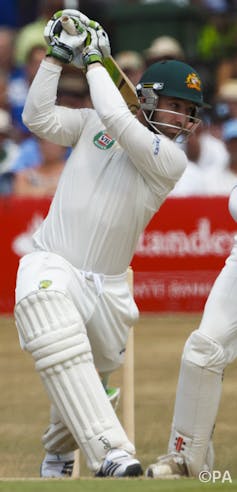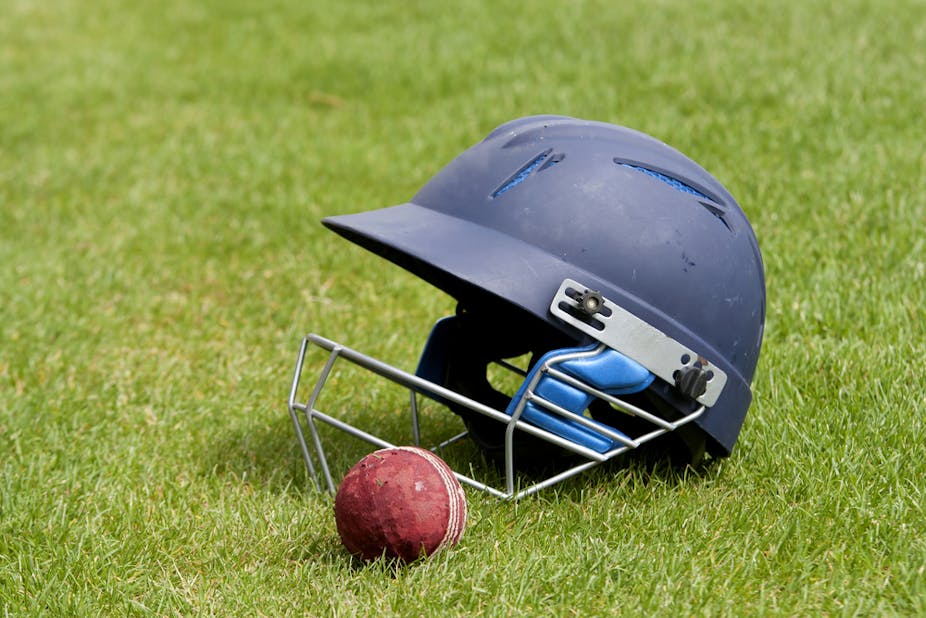The tragic death of 25-year-old Australian cricketer Phillip Hughes after he was hit on the back of the head by a cricket ball has shocked followers of the sport around the world and raised questions about the safety of its players.
Hughes was wearing a helmet made by the manufacturers Masuri, but not its latest model which has been improved this year to give more protection.
The Conversation spoke to Andy Harland, senior lecturer in sports technology at Loughborough University, who has been involved in research on safety standards for cricket helmet design, on whether further changes are needed in the wake of Hughes’s death.
Should there be a review of helmet design as a result of Hughes’s death?
There should always be an ongoing discussion of anything to do with safety in sport. Tragic incidents like this bring it into focus and we should do everything we can to understand the precise detail of the injury Phil Hughes suffered. Whilst every sympathy goes out to those affected by his death, it doesn’t actually change anything about the game in terms of managing that risk. It was an utterly unfortunate accident.
Safety equipments exist in a compromise position. We think of it in a little triangle: safety, comfort and performance. If you said to a professional cricket player, we can guarantee that you would be 100% safe with this helmet, but you would be uncomfortable when you play and you would not perform to your best, then there is every likelihood that a test match player would be willing to take more risk.
Some manufacturers do make helmets that are more or less comfortable to wear and they may or may not be compromising safety. So long as that information is very public and so long as there is transparency that allows a player to make an informed choice, then they have the right to make that choice.
Could a different helmet with protection on the back of the head and neck have prevented his death?

If Hughes had been wearing a motorcycle helmet he would probably be alive today. He almost certainly wouldn’t have scored a run though. It’s that compromise. I think there’s scope for manufacturers offering more protection on the neck as an option, but there’s nothing like that on the market today. Fashion and other issues might have meant it would be commercially unsuccessful. But that may have well changed overnight.
If it is marketed to the tail-end batsmen who come later down the order, perhaps one or two of those guys might be willing to compromise on their mobility. If a manufacturer can design a helmet offering increased protection on the neck without compromising mobility, I am sure it would be very popular.
*Do you think this accident will make helmets mandatory in the game? *
Helmets are not mandatory at the moment and I think it’s unlikely in practice that they will become so now.
There is now some evidence that if you really were to increase the level of protection at the cost of mobility, then you might expect more people to be hit. You just hope that when they are hit, the protection is effective at preventing injury.
We’ve carried out some initial tests ourselves at Loughborough that might steer the direction of future studies. These looked at things like the weight of the helmet and its thermal properties – whether it causes your head to heat up. It looked at whether your ability to think clearly or to react was impacted by the length of time you were wearing head protection. Remember small fractions of a second can be the difference between being hit or avoiding a blow. We found that it might, but more research is needed to draw any meaningful conclusions.
What recent improvements have been made to cricket helmets?
Two years ago, a group including representatives from the International Cricket Council, the Professional Cricketer’s Association, the England and Wales Cricket Board, the British Standards Institute and most of the major manufacturers joined together to revise the British standard for helmets. The remit was based on injuries that have become prevalent when the ball passes between the facial grill and the helmet. We revised it to specifically address that shortcoming.
We created an additional test that is required for a helmet, which involves firing a ball at the face of the helmet at match-realistic speeds and checking that neither the ball nor the facial grill itself comes into contact with the face on impact.
At the time when we first started looking at this, it’s probably fair to say that for almost all the helmets on the market, you could have found circumstances that they failed this test. It was an area that needed improvement across the board. Over the past two years, this has allowed medics, manufactures and researchers at universities to all work together and share knowledge about helmet design.
The standard has been redrafted and was adopted in December 2013 so we are in the phase now of it going live. The first new helmets, designed to meet this new standard should be on the market soon. I hope that cricketing authorities and players around the world will choose to wear accredited helmets and replace them when they are damaged, even if it is unlikely they will become mandatory.
*Could this tragedy make more amateur cricketers wear helmets?
*
I certainly hope it takes away any remaining stigma associated with wearing a helmet at any level of the game. I hope it means that amateur players will think carefully about their safety needs, that they will look after the products and check them regularly when they do play. People should be provided with good quality facts about their options and be fully aware of the risks they are taking if they choose not to wear a helmet.
But I think it would be a real shame if young people and recreational cricketers choose not to play as a result of this injury. According to the doctor in Australia who treated Hughes, there have been only 100 cases of this injury ever reported in medicine in history. You have to put it down to an accident and, despite the tragedy of Phillip Hughes’s death, the risk hasn’t changed.

